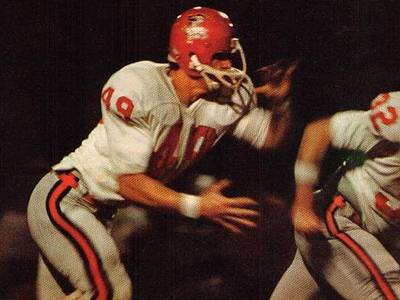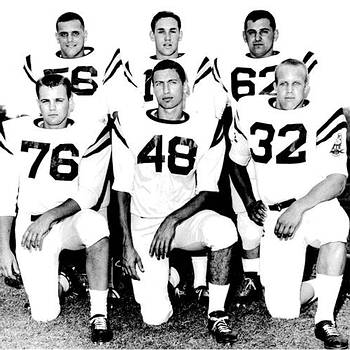

"Small School.... Big Memories Part 2"
HELMET HUT NEWS/REFLECTIONS November 2010:
Small Schools Can Hold Big Memories, Part 2
By Dr. Ken
The HELMET NEWS/REFLECTIONS column of October found many who could relate to what was previously referred to as “Small College Football.” Certainly, high school football hotbeds like Florida, California, and Texas produce significant numbers of Division One scholarship football players annually. New York State is on the other end of the spectrum despite its large population, and Long Island specifically, can boast of no more than a half dozen legitimate D 1 recruits in any season. There have been many individual stars to come out of the two county Island, with few bigger and better known than Jim Brown who of course starred at Syracuse and with the Cleveland Browns. Ranging from “known by everyone” to “he played but remains obscure,” Long Island football players have made a name at both major colleges and in the pro ranks. Brown remains revered but older fans will also recall Bob Reifsnyder. “Reef” as he was known, was an All American at the U.S. Naval Academy in his junior season of 1957, and the first guard or tackle to win the Maxwell Award. John Mackey, Matt Snell, quarterbacks “Boomer” Esiason, Vinny Testaverde, and Jay Fiedler, the Baldinger and Tice brothers, and many more have given Long Island a healthy tradition but one that cannot compare to the “big time” high school regions of the south and southwest. With Long Island football usually taking a back seat to and often a bad rap from coaches and players from other areas of the country, many very good players have always filled the rosters at Small Colleges. Many of the so-called small college programs of the 1950’s and ‘60’s routinely turned out professional players who made their mark in the NFL or CFL and college football on Long Island itself was often of very high caliber.
As college football’s landscape has changed through the decades, often for financial reasons and sometimes due to demographics, the designation between small school and major program has blurred and some colleges remain in a netherworld between divisions. In the 1960’s, there were a few “major” publications that offered a pre-season outlook for college football.
|
|
My favorite was
Street And
Smith
as it seemed to
offer more names of
individual players
and specific
coaches’ comments.
Kickoff
unfortunately was
around for only a
limited time while
Football
Roundup
plugged away for
less than two
decades. These never
offered as much
information as
Street And
Smith
but seemed to
provide a bit more
coverage and photos
of the Mid America
Conference and
lesser known
schools.
|
|
Sports Illustrated’s annual College Football edition would have a theme that at times proved interesting, especially if accompanied by color photos. For some corporate reason, many if not most of the early 1960’s issues eschewed photos in favor of drawings which I never found satisfying. In all of these publications, there would be a “Small College” summary, sometimes highlighting individual schools with enlightening detail.
 |
Calvin Harrell of Arkansas State was a devastating Small College fullback and Little All American. He had a productive career in the CFL
Arkansas State, the so-called “Directional Schools” in Louisiana such as Southwest Louisiana State, and Troy State were all considered “small college” programs, yet today help to form the Division One Sun Belt Conference. North Dakota and North Dakota State among others were always winners and both highly ranked and well thought of in the so-called small college ranks, yet are not “small” with enrollments of approximately 15,000 – 16,000 students, and both boast a number of players who matriculated to the pro ranks in the U.S. and Canada. The shifting economy and cultural changes have seen some schools like Parsons College and Yankton close their doors, others like Long Island’s Hofstra and Adelphi Universities drop football, and some such as West Texas State (now West Texas A&M) leave the higher classifications. Some of the storied and traditionally strong football playing schools like Mount Union and John Carroll in Ohio, Emporia State and Pittsburg State in Kansas for example, remain at what is now the Division Two level, yet play football and boast facilities that are competitive with many Division One programs.
 |
Note Owl mascot on sleeve of Fullback Mike Katz, #32 of Southern Connecticut State University. Small colleges were often in the forefront of uniform design innovations which were then copied by the major colleges.
One thing lost upon many typical college football fans is that fact that today’s “small college football,” while in many ways encompassing different schools and in some cases, little known schools in some parts of the nation, still provides much of the same exciting and enjoyable viewing as the largest programs do, and often with just as much fan enthusiasm. Often too, the uniforms and of course, the helmets, are more striking, in part because the designs are not limited by the demands or intrusion of corporate sponsors. Small college football continues to serve as an avenue for “local” young men to continue their participation and that of parents, relatives, and friends to remain involved in the game. Small college football is often essential in providing the structure of social life in many smaller towns. There is not only a place for small college football in today’s economy and glut of television packages, it remains a necessity.